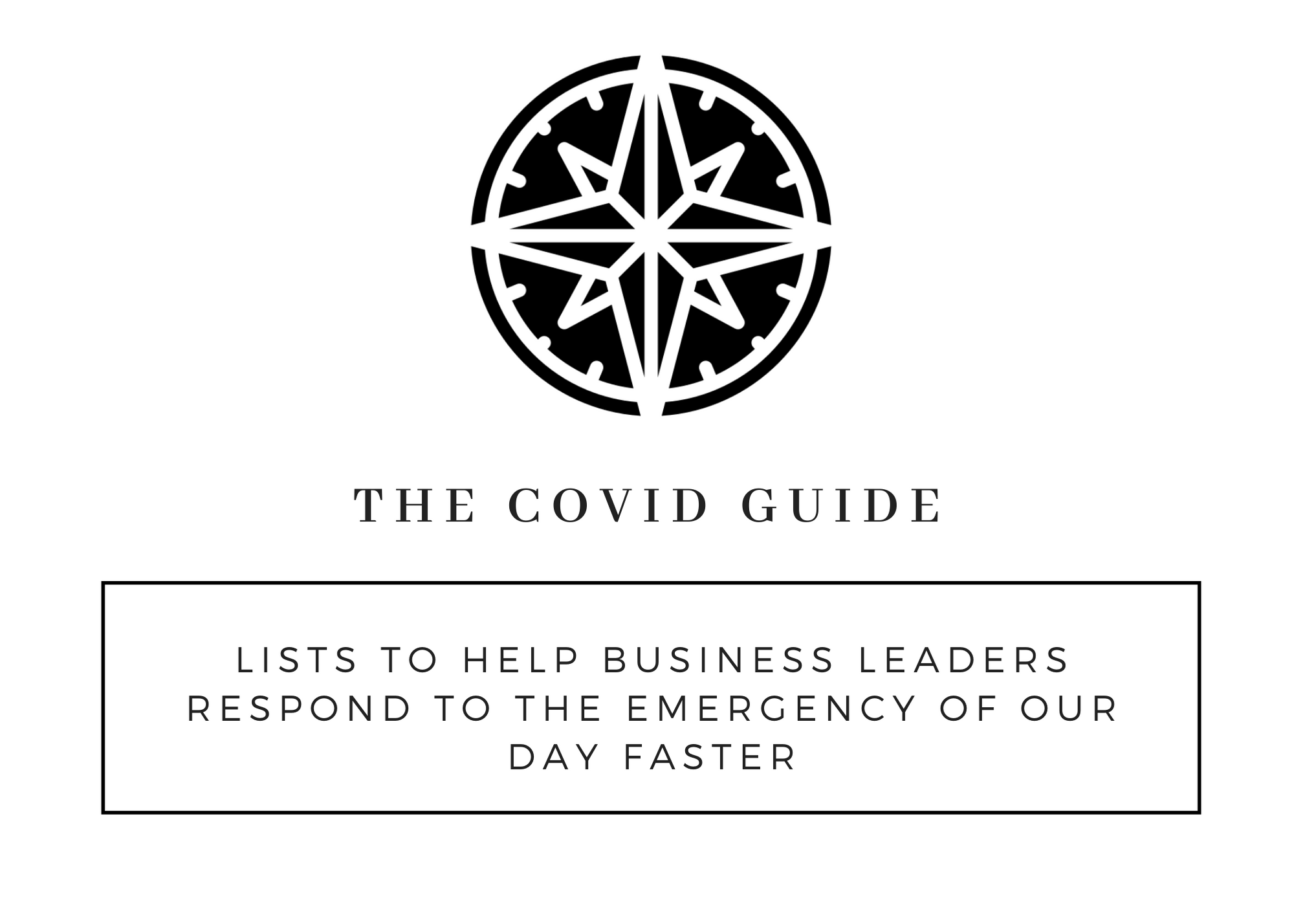The following list is a compilation of action items for Financial Best Practices during the COVID-19 pandemic and other similar crises. With 50 years of experience in IT consulting, we have weathered the storms of the past five decades and believe that it is our responsibility to provide our expertise in organizational crisis management. In addition to our own knowledge, we have taken the input of other CFOs, etc. We are pleased to share this under a Creative Commons license.
Finance Department Emergency Checklist
Team
- Identify your crisis management team and delegate areas of responsibility and communicate expectations
- The crisis management team should consist of business leaders from:
- Operations
- Sales
- Marketing
- Finance
- Human Resources
- IT
- May include external advisors where appropriate
- Establish a cadence for the team to meet and expectations for the meeting and ground rules for communication of meeting discussion points outside of the crisis management team.
- The crisis management team should consist of business leaders from:
- Ensure that your long-term strategy and objectives are understood by each member of your crisis management team
- Solicit their commitment to be great leaders and help the company achieve an effective balance between actions necessary for survival in the short-term and maintaining skilled employees, culture, trust and organization capability required to achieve long-term success after the crisis abates
Forecasting
- Identify potential risks that each of your major customers face relative to
- anticipated changes in the market
- their individual capitalization and geographic profile and stability
- Understand how these risks could impact your business
- If your business does not have major customers, perform the same assessment for the markets and channels that you serve
- Develop a two-quarter rolling financial forecast based on a combination of direct customer and industry feedback and your assessment of underlying risks
- Identify and monetize opportunities and risks to forecast
- The forecast should consist of profit and loss statements, a balance sheet and statement of cash flows and any key metrics that you follow or require for compliance purposes
- For medium-range planning purposes, evaluate your cash flow, liquidity and borrowing positions for each period represented in your forecast and identify deficiencies in working capital versus target levels or debt covenant compliance
- Understand how the identified risks and opportunities could impact:
- Cash flow
- Working capital
- Liquidity
- Compliance
- Update the forecast on a real-time basis as you receive feedback from your business unit leaders, sales team and cost center owners
- Communicate with and educate the management team on the current and projected financial situation and deficiencies in financial performance and liquidity compared to established business targets
- Work with your senior management team to prioritize spending and identify requirements for expense reduction
- Understand how the identified risks and opportunities could impact:
Expense Reduction
- It is often helpful to identify the detail of your recent and forecasted expenses into variable, fixed and discretionary categories and assign ownership to each expense line item
- When it is necessary to reduce the level of spending in your business, it is important to start the exercise with a target in mind for each period
- Assign expense reduction objectives to each cost center owner based on:
- The nature of the expense they control;
- Relative business impact; and
- Opportunity for reduction
- It is recommended that the CFO over-assign expense targets to cost center owners and require a business assessment from the cost center owners when receiving their recommendations so that senior leaders can do their best to
- Prioritize spending reductions and
- Preserve the capability of the business to succeed after the downturn.
- Provide the following information for each line item of reduction:
- Description of reduction
- Expense category – discretionary or fixed cost
- Resources impacted
- Timing in which the savings begin and savings per period
- Any transition costs which may be incurred and their timing
- Full year savings for any reductions implemented mid-year
- The impact to the business in terms of reduced capacity, capability, sales, quality, customer service
- Cross-functional transition assumptions that might involve another function or business unit
- Assign expense reduction objectives to each cost center owner based on:
Credit and Collections
- Evaluate the credit risk associated with your top-customers and the markets and channels you serve based on anticipated changes in their revenues and financial stability
- Determine whether you should make changes in credit or terms with individual customers or for your overall business.
- Implement real-time processes to actively monitor the payment trends of your customer base.
- Consider implementing touch points for major customers one week in advance of the scheduled due date for significant invoices to confirm with the customer that they have everything they need to make timely payment or if they anticipate any obstacles.
- Take immediate action on adverse payment trends, communicating with the customer to understand the nature of the delay and receive a committed timeline for payment while at the same time acknowledging and preserving the value of the customer relationship.
Lending
- In connection with your forecast process, evaluate your current and future compliance with debt covenants and your ability to pay debt service amounts to ensure that you retain your access to capital.
- If you project a compliance or debt service issue that cannot be immediately resolved through cost reduction or improved working capital management, work through a remediation plan with members of your crisis management team quickly and have an early discussion with your banker.
- Remember that most debt agreements require you to also disclose adverse changes in the condition of the business.
- Many business owners will draw the maximum amount available on their line of credit when they encounter a crisis or a period of financial difficulty.
- You will need to make that decision based on the severity of your cash flow situation, your relationship and track record with your bank, your access to other capital and your assessment of whether access to bank financing is at risk.
- Many feel that drawing the maximum amount on the line of credit forces the bank to negotiate with you in the event of a technical covenant or payment default rather than cancelling access to financing or calling the loan.
- Besides conventional bank financing, there are other sources of capital that might be available to your business including SBA 7(a) working capital, disaster, 504 long-term loans, asset-based loans (ABL) and factoring. SBA loans provide additional flexibility due to the government guarantee, but they generally require a personal guarantee from all 20% or more shareholders or the chief operating executive if ownership is more distributed.
- Asset based loans and factoring are based on the value of your accounts receivable or inventory
- These loans generally more expense forms of financing, may require personal guarantees, require a bank lockbox to be utilized for cash receipts and carry monitoring and lockbox fees which can be cost prohibitive for smaller lines of credit
Vendor Management
- Identify vendors that are critical to the operation of your business including key service providers, contractors and other suppliers
- Assign responsibility for relationship management and risk assessment to members of your crisis management team
- Identify major risks that your most critical vendors might face relative to anticipated changes in the market and understand how these risks could their ability to continue to operate and service
- Members of your crisis management team should have open discussions with your vendors on their plans, stability and continued viability
- Identify alternatives to critical vendors for those that are in high risk positions that could adversely impact your business
- In the event of a financial disruption to your business, you can ask vendors for discounts to their standard rate structures, a deferred payment plan, flexibility in the ability to reduce service levels or pause services for a period of time or a waiver of cancellation fees
- You are most successful if you ask for these for a reasonable and specific period of time, generally 30 to 90 days
Cash Management
- Either evaluate and update or establish target levels of cash and liquidity for your business that may be required considering current levels of risk and potential volatility in revenues and cash flow
- Update and evaluate or establish a rolling 13-week cash flow forecast with enough detail to provide an understanding of the major categories of expenditures and the cash inflows expected from collections from your major customers and markets
- For each week of the cash flow forecast, evaluate your cash and liquidity position relative to target.
- Identify potential deficiencies in cash and liquidity versus your targets and proactively develop solutions to improve cashflow to meet your targets. These can include:
- Implementing expense reductions to achieve target levels of cash and liquidity.
- Changes in vendor payment terms and payment timing.
- Eliminating unprofitable activities, customers and services.
- Cancellation or delay of capital equipment purchases.
- Securing additional financing or capital.
- To the extent possible, establish a consistent payment day each week for updating the cash flow forecast, ensuring it is consistent with you banking and accounting records, and for paying vendor invoices.
- Create a “cash flash” report that is distributed at least weekly to select members of your crisis management team
- The cash flash report should include:
- A recap of current week collection and payment activity versus the cash flow forecast
- Summarize the cash flow forecast for the next two weeks forward
- Include summaries of customer account balances each week that are past due so that this remains visible to the management team
- The cash flash report should include:
External Resources
- There are several external resources that can be used to help your business through a crisis, and which provide critical information for business owners. These include:
- Your state commerce authority or economic development center,
- Local chambers of commerce
- Small Business administration (SBA) and SBA Lenders
- Small Business Development Centers located in your state
- SCORE
- CFO Consulting Firms
- Trade associations
- CEO forums can provide valuable advice from experienced business owners – YPO, EO, Vistage




